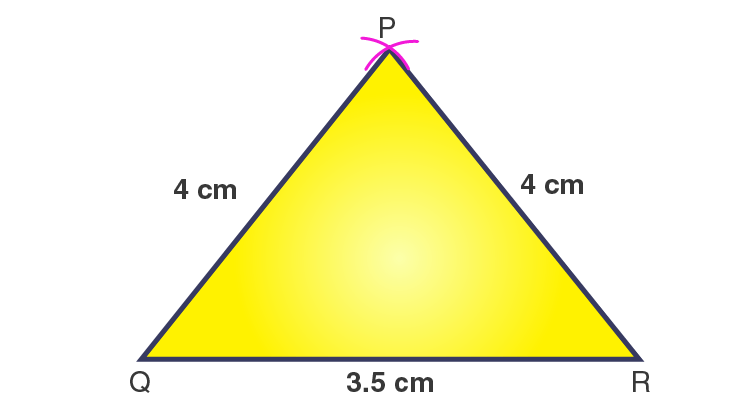Exercise 10.2 Page: 199
1. Construct ΔXYZ in which XY = 4.5 cm, YZ = 5 cm and ZX = 6 cm
Solution:-

Steps of construction:
1. Draw a line segment YZ = 5 cm.
2. With Z as a center and radius 6 cm, draw an arc.
3. With Y as a center and radius 4.5 cm, draw another arc, cutting the previous arc at X.
4. Join XY and XZ.
Then, ΔXYZ is the required triangle.
2. Construct an equilateral triangle of side 5.5 cm.
Solution:-

Steps of construction:
1. Draw a line segment AB = 5.5 cm.
2. With A as a center and radius 5.5 cm, draw an arc.
3. With B as a center and radius 5.5 cm, draw another arc, cutting the previous arc at C.
4. Join CA and CB.
Then, ΔABC is the required equilateral triangle.
3. Draw ΔPQR with PQ = 4 cm, QR = 3.5 cm and PR = 4 cm. What type of triangle is this?
Solution:-

Steps of construction:
1. Draw a line segment QR = 3.5 cm.
2. With Q as a center and radius 4 cm, draw an arc.
3. With R as a center and radius 4 cm, draw another arc, cutting the previous arc at P.
4. Join PQ and PR.
Then, ΔPQR is the required isosceles triangle.
4. Construct ΔABC such that AB = 2.5 cm, BC = 6 cm and AC = 6.5 cm. Measure ∠B.
Solution:-

1. Draw a line segment BC = 6 cm.
2. With B as a center and radius 2.5 cm, draw an arc.
3. With C as a center and radius 6.5 cm, draw another arc, cutting the previous arc at A.
4. Join AB and AC.
Then, ΔABC is the required triangle.
5. When we will measure the angle B of triangle by protractor, then angle is equal to ∠B = 90o